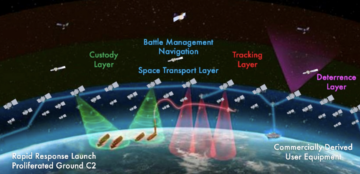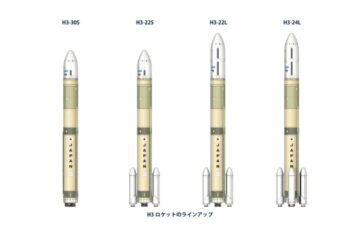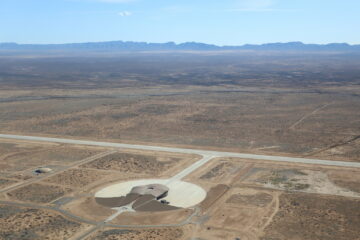WASHINGTON — U.S. Space Force operators will be responsible for flying a new fleet of satellites that will monitor ground targets in near-real time virtually anywhere in the world, a senior official said Feb. 13.
This network of satellites, known as Ground Moving Target Indicator (GMTI), is being developed by the National Reconnaissance Office in partnership with the Space Force. These sensors in space would give commanders on the ground persistent video-like surveillance capabilities that in the past were provided by aircraft such as the U.S. Air Force’s Joint Surveillance Target Attack Radar System (JSTARS).
The Air Force stopped flying JSTARS due to its vulnerability in modern warfare scenarios and the Pentagon instead is investing in a network of satellites, other aircraft sensors and ground radars, all contributing to a broader picture of the battlefield.
Although the NRO has a central role in the design and development of the GMTI constellation, the Space Force will be the lead operator of the system, said the deputy chief of space operations of the U.S. Space Force Lt. Gen. DeAnna Burt.
Space Force guardians will directly task and control where the satellites point their sensors based on requests from regional combatant commanders, Burt said during a panel discussion at the Air & Space Force Association’s Warfare Conference in Aurora, Colorado.
While the NRO is partnering with the Space Force and will have access to the data from GMTI, Burt emphasized that the military chain of command will drive the program based on priorities approved by the Joint Chiefs of Staff at the Pentagon.
But she added that “guardians will fly that satellite shoulder to shoulder with the National Reconnaissance Office to provide those capabilities. So there is a definite partnership there with the intelligence community.”
GMTI an ‘operational imperative’
The Space Force requested about $1.2 billion for the program in its five-year 2024-2028 spending plan. It’s unclear if the start of the program has been delayed as the federal government’s budget for 2024 has not yet been approved by Congress.
According to DoD budget documents, GMTI “is an integral part of the Department of the Air Force’s operational imperative of achieving moving target engagement at scale in a highly contested environment.”
Many details of the program are classified, such as the size of the GMTI constellation or what sensors the satellites will carry.
Burt said she expects other surveillance and reconnaissance missions traditionally performed by aircraft to transition to space sensors.
“In denied environments, we’ve seen big-wing ISR [intelligence, surveillance, reconnaissance] has problems getting into the fight,” she said. “That’s going to be difficult. So we’re going to see many phenomenologies go to the space domain, not just the GMTI.” A denied environment refers to combat zones protected by anti-aircraft missiles or other air-defense systems.
GMTI is “laying the groundwork for where we go in the future and how to provide that critical ISR capability not only to the joint force, but also critical space domain awareness,” Burt said. “And the intelligence community will have access to anything collected from these platforms.”
‘A game changer’
A capability like GMTI “has never been done before,” said Brig. Gen. Devin Pepper, vice commander of the Space Force’s Space Operations Command.
“Space-based targeting directly to the warfighter, directly to the shooters, is a game changer,” he told reporters at the AFA conference.
Pepper said his command, known as SpOC, was directed to lay out a plan for how GMTI will be operated, maintained and how crews will be trained.
“We’re taking the lead on looking at all the requirements associated with how the system is delivered, how we operate it and how we sustain it, in conjunction with the NRO,” Pepper said.
Pepper previously worked at the NRO and praised the agency for its expertise at building satellites. “What they do is fantastic. They’re very good at building satellites,” he said.
But Pepper insisted that GMTI will be a military system operated in support of the armed forces, and he echoed Burt’s comments that the data will be shared with the intelligence community.
- SEO Powered Content & PR Distribution. Get Amplified Today.
- PlatoData.Network Vertical Generative Ai. Empower Yourself. Access Here.
- PlatoAiStream. Web3 Intelligence. Knowledge Amplified. Access Here.
- PlatoESG. Carbon, CleanTech, Energy, Environment, Solar, Waste Management. Access Here.
- PlatoHealth. Biotech and Clinical Trials Intelligence. Access Here.
- Source: https://spacenews.com/future-military-target-tracking-satellites-to-be-operated-by-u-s-space-force/
- :has
- :is
- :not
- :where
- 07
- 13
- 2%
- 2024
- 52
- a
- About
- access
- achieving
- added
- agency
- AIR
- Air Force
- aircraft
- All
- also
- an
- and
- anything
- anywhere
- approved
- ARE
- armed
- AS
- associated
- At
- attack
- Aurora
- awareness
- based
- Battlefield
- BE
- been
- before
- being
- Billion
- broader
- budget
- Building
- but
- by
- capabilities
- capability
- carry
- central
- chain
- Changer
- chief
- classified
- collected
- Colorado
- combat
- comments
- community
- Conference
- Congress
- conjunction
- contributing
- control
- critical
- data
- Delayed
- delivered
- denied
- Department
- deputy
- Design
- details
- developed
- Development
- Devin
- difficult
- directed
- directly
- discussion
- do
- documents
- DoD
- domain
- done
- drive
- due
- during
- echoed
- emphasized
- engagement
- Environment
- environments
- Ether (ETH)
- expects
- expertise
- fantastic
- Feb
- Federal
- fight
- FLEET
- flying
- For
- Force
- Forces
- from
- future
- game
- game-changer
- Gen
- getting
- Give
- Go
- going
- good
- Ground
- groundwork
- Guardians
- Have
- he
- highly
- his
- How
- How To
- HTTPS
- if
- imperative
- in
- Indicator
- instead
- integral
- Intelligence
- into
- investing
- IT
- ITS
- joint
- just
- known
- lay
- lead
- like
- looking
- maintained
- many
- Military
- missiles
- missions
- Modern
- Modern Warfare
- Monitor
- moving
- National
- network
- never
- New
- of
- Office
- official
- on
- only
- operate
- operated
- operational
- Operations
- operator
- operators
- or
- Other
- out
- panel
- panel discussion
- part
- partnering
- Partnership
- past
- pentagon
- performed
- picture
- plan
- Platforms
- plato
- Plato Data Intelligence
- PlatoData
- pm
- Point
- Praised
- previously
- problems
- Program
- protected
- provide
- provided
- radar
- refers
- regional
- requested
- requests
- Requirements
- responsible
- Role
- s
- Said
- satellite
- satellites
- Scale
- scenarios
- see
- seen
- senior
- sensors
- shared
- she
- Size
- So
- Space
- Space Force
- Spending
- Staff
- start
- such
- support
- surveillance
- system
- Systems
- taking
- Target
- targeting
- targets
- Task
- that
- The
- The Future
- the joint
- the world
- their
- There.
- These
- they
- those
- time
- to
- told
- traditionally
- trained
- transition
- u.s.
- U.S. Space Force
- unclear
- very
- vice
- virtually
- vulnerability
- was
- we
- were
- What
- will
- with
- worked
- world
- would
- would give
- yet
- zephyrnet
- zones










